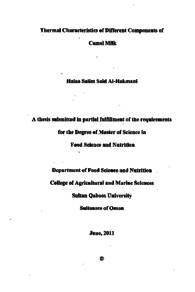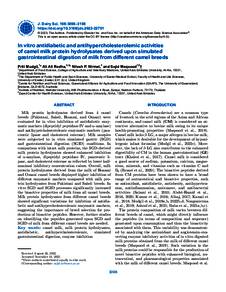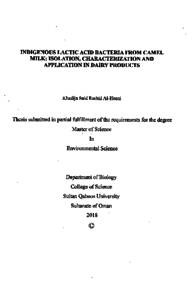وثيقة
Thermal characteristics of different components of camel milk
الناشر
Sultan Qaboos University
ميلادي
2011
اللغة
الأنجليزية
الموضوع
الملخص الإنجليزي
Milk is a multicomponent mixture containing mainly water, protein, fat, lactose and other minor constituents, thus it is a challenge to trace different state and phase changes from its complex thermogram as measured by Differential Scanning Calorimetry (DSC). In the literature, negligible research works are reported on the thermal characteristics of camel milk power, especially for different components of camel milk. This is mainly due to the complex interactions between different types of complex components present in the milk. Thermal characteristics of freeze-dried whole and skimmed camel milk were measured by DSC. The thermogram showed three endothermic peaks (two for fat-melting and other for non-fat solids-melting) and three shifts. Two shifts at low temperature could be related to the glass transitions. However, it was difficult to identify which components in the milk were providing these transitions. The shift at higher temperature after melting of non-fat solids could be related to structure ordering in the milk. However, it was difficult to trace the glass transitions of each component in the milk due to the complex interactions of the components' phases. For this reason, different components of the camel milk (fat, cream, casein, whey protein, and lactose) were separated and then measured its thermal characteristics. The thermogram of camel milk fat showed two endothermic peaks, one wide and the other sharp. The wide peak at low temperature was due to the melting of different fractions of fatty acid and the sharp peak indicated melting of a significant amount of specific fatty acid. The melting of fat started at -5°C and ended at 52°C, respectively. The melting of fat in cream started at lower temperature -12°C as compared to the pure fat at -5°C. This decrease in melting temperature could be due to the effects of protein content in the cream. Casein showed one endothermic peak due to non-fat solids-melting and two shifts in the thermogram line indicating two glass transitions. The first glass transition started at 38°C, second glass transition started at 77°C and melting onset at 95°C, respectively. Similarly whey protein precipitated by ammonium sulfate and ethanol also showed two glass transitions and one melting endotherm. In the cases of all types of protein, the second glass transition was observed just before melting of non fat solids. In the case of first scan of lactose, only two endothermic melting peaks were observed without any trace of glass transition. However, the second scan with annealing showed two glass transitions and two endothermic peaks. The onset of the first and second glass transitions were at 56 and 114°C, respectively. Similarly the onsets of first and second melting endotherms were at 145 and 213°C, respectively. In case of commercial lactose, the glass transition could not be traced, however two similar melting endotherms were observed, first one at 141°C and second one at 215°C, respectively.
المجموعة
URL المصدر
الملخص العربي
الحليب هو خليط متعدد المكونات يتكون بشكل رئيسي من ماء، البروتين، والدهون، واللاكتوز ومكونات ثانوية أخرى، وبالتالي فان رسم المخطط الحراري (thermogram) المعقد الذي يقاس بواسطة جهاز DSC يعتبر تحديا لتتبع متغيرات الحالة والتغيرات الأخرى. في المراجع العلمية، بحوث قليله عملت ونشرت حول قياس الخصائص الحرارية لحليب الإبل البودره، ولا سيما المكونات حليب الإبل المختلفة. ويرجع هذا بشكل رئيسي بسبب التفاعلات المعقدة بين الأنواع المختلفه من المكونات المعقدة الموجودة في الحليب. أولا الخصائص الحرارية الحليب الإبل المجفف بالتجميد كامل الدسم و منزوع الدسم تم قياسهما بواسطة جهاز DSC. وأظهر المخطط الحراري ثلاث قمم ماصه للحرارة (اثنان لذوبان الدهون والأخر لذوبان المواد الصلبة غير الدهن)، وثلاث تحولات بالمخطط الحراري. اثنان من التحولات لوحظت على درجة حرارة منخفضة من المحتمل أنها تشير الى التحول الزجاجي (transition the glass). على أية حال، كان من صعب التميز اي مكون من مكونات الحليب مسببه لهذه التحولات الزجاجية. أما التحول الأخير الذي لوحظ عند درجة حرارة عالية واظهر تغير بعد ذوبان المواد الصلبة غير الدهن قد يعود إلى التركيب الجزئي في الحليب. وكان من الصعب تتبع التحول الزجاجي (the glass transition) بسبب التفاعلات المعقدة بين مراحل المكونات. لهذا السبب، تم فصل المكونات المختلفة لحليب الإبل (الدهن النقي، وكريم، و بروتين الحليب(casein protein) ، وبروتين مصل الحليب (whey protein)، واللاكتوز) ثم تم قياس خصائصها الحرارية. وأظهر المخطط الحراري من دهن حليب الأبل قمتين ماصه للحرارة، واحده على قمة واسعة وأخرى حادة. وكانت القمه الواسعه عند درجة حرارة منخفضة بسبب ذوبان أجزاء مختلفة من الأحماض الدهنية والأخرى ترجع الى ذوبان احماض دهنية معينة بنسبة كبيرة. وبدأ ذوبان الدهون عند -5 درجة مئوية، وانتهى عند ۵۲ درجة مئوية، على التوالي. ذوبان الدهون في الكريم بدا عند درجة حرارة - ۱۲ درجة مئوية أقل بالمقارنة مع الدهن النقي عند -5 درجة مئوية. وهذا الانخفاض قد يكون راجعا إلى تأثيرات البروتين المتواجده في الكريم وأظهر بروتين الحليب (casein protein) قمه واحده ماصه للحرارة بسبب ذوبان المواد الصلبة غير الدهن واثنين من التحولات في خط المخطط الحراري تشير الى اثنين من التحولات الزجاجية. بدا التحول الزجاجي الأول عند ۳۸ درجة مئوية والتحول الثاني عند ۷۷ درجة مئوية، والاذابة بدات عند ۹۰ درجة مئوية، على التوالي. وبالمثل ظهر عند بروتين مصل الحليب (whey protein) الذي تم فصله بالملح والكحول لوحظ اثنين من التحولات الزجاجية وواحده لقمة ماصة للحرارة. في حالات كل انواع البروتين، التحول الزجاجي الثاني لوحظ مباشرة قبل ذوبان المواد الصلبه غير الدهن. في حالة اللاكتوز من المسح الأول لوحظ اثنين فقط من قمم ذوبان ماصه للحرارة من دون أي أثر للاتحول الزجاجي. وعند اجراء المسح الحراري للاكتوز مع تلدين (annealing) تلاحظ وجود تحولاین زجاجيين وإثنان لقمع ماصه للحرارة. بدا التحول الزجاجي الأول عند 56 درجة مئوية والتحول الثاني عند 114 درجة مئوية، على التوالي. وبالمثل بدات الإذابة الأولى عند 145 درجة مئوية و الثانية عند ۲۱۳ درجة مئوية، على التوالي. أما في حالة اللاكتوز الصناعي فان التحول الزجاجي لم يلاحظ برغم من انه تلاحظ اذابتين متشابهتين لقمم ماصه للحرارة، الأولى بدات عند ۱4۱ درجة مئوية والثانية عند ۲۱۰ درجة مئوية، على التوالي.
قالب العنصر
الرسائل والأطروحات الجامعية



